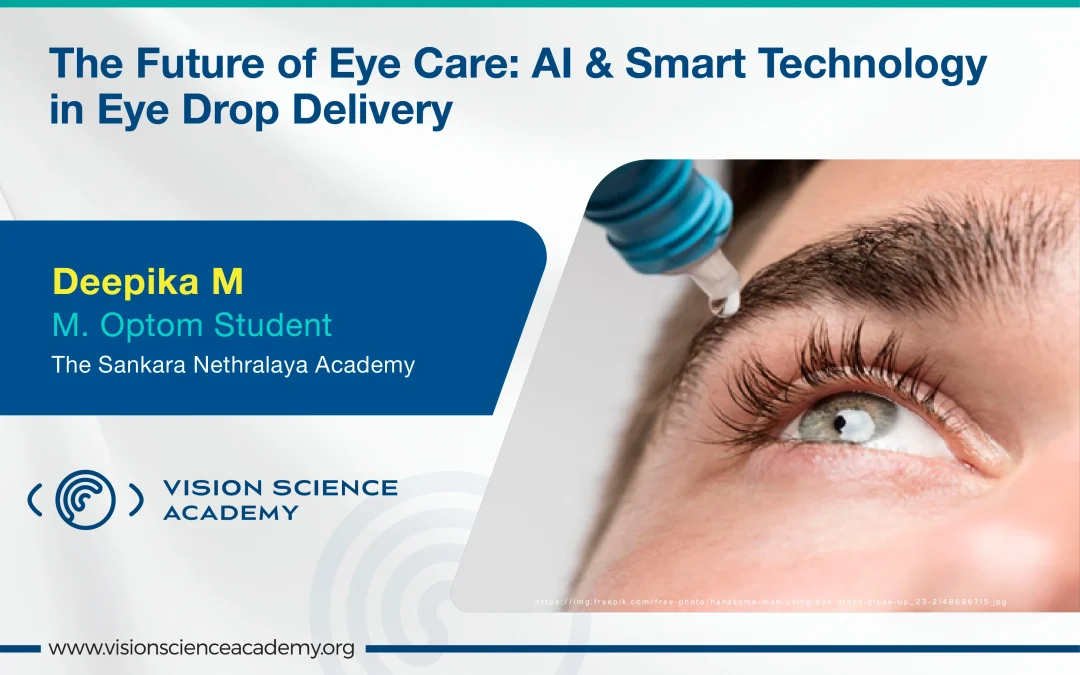Deepika M, B.Optom.
M.Optom Student, The Sankara Nethralaya Academy, Chennai, India
Smart technology and artificial intelligence are revolutionising the approach to eye drop application by offering fresh ideas to solve patient adherence and maximise therapeutic results.
Challenges in Eye Drop Administration and AI-Driven Innovations
To effectively manage glaucoma and viral keratitis, accurate eye drop instillation is crucial. However, most studies highlight the persistent challenge of ensuring patients follow prescribed regimens. Common issues include improper application techniques, forgetfulness, and a general lack of understanding regarding eye drop usage. For instance, patients with corneal diseases often show low adherence, which negatively impacts treatment outcomes and accelerates disease progression. (1,2)
Advancements in artificial intelligence (AI) have introduced smart solutions aimed at overcoming these challenges. One notable innovation is the smart electronic eye drop container, designed to unobtrusively monitor eye drop usage. Equipped with sensors, this device tracks the timing and frequency of eye drop administration, providing real-time data to both patients and healthcare providers. This immediate feedback allows for timely interventions and targeted education, significantly improving adherence rates. (3)
Further integrating AI into ophthalmic care, smartphone-based applications now offer advanced support for patients. These apps utilise AI algorithms to guide users through correct instillation techniques, send reminders for medication schedules, and even assist in diagnosing eye conditions using the smartphone’s camera. A systematic review has highlighted the effectiveness of such technologies, demonstrating their potential in patient management and telemedicine. (4)
Pushing the boundaries of innovation, smart contact lenses embedded with AI are redefining ocular healthcare. These lenses not only facilitate continuous health monitoring but also support real-time disease detection. They track critical ocular metrics, such as intraocular pressure, and provide instant data analysis using AI algorithms. This enables early diagnosis and timely treatment interventions, revolutionising the approach to eye care. (5)
The combination of AI and smart technologies in eye drop delivery and ocular health monitoring has enormous potential for the future of ophthalmic treatment. These developments have the potential to improve patient outcomes and set new standards of care in this field by making it easier for patients to manage their medications while also delivering innovative disease detection methods to solve medication adherence issues.
References:
- Khan, M., Michelson, S., Newman-Casey, P. A., & Woodward, M. A. (2021). Medication Adherence Among Patients With Corneal Diseases. Cornea, 40(12), 1554–1560. https://doi.org/10.1097/ICO.0000000000002680 .
- Tabuchi, H., Nishimura, K., Akada, M., Ishikami, T., Shirakami, T., Kamiura, N., & Kiuchi, Y. (2024). Real-world evaluation of novel eye drop bottle sensors: Cloud-based AI support for eye drop adherence. Heliyon, 10(14), e34167. https://doi.org/10.1016/j.heliyon.2024.e34167
- Aguilar-Rivera, Marcelo & Erudaitius, Dieanira & Wu, Vincent & Tantiongloc, Justin & Kang, Dae & Coleman, Todd & Baxter, Sally & Weinreb, Robert. (2020). Smart Electronic Eyedrop Bottle for Unobtrusive Monitoring of Glaucoma Medication Adherence. Sensors. 20. 10.3390/s20092570.
- Jin, Kai & Li, Yingyu & Wu, Hongkang & Tham, Yih & Koh, Victor & Zhao, Yitian & Kawasaki, Ryo & Grzybowski, Andrzej & Ye, Juan. (2024). Integration of smartphone technology and artificial intelligence for advanced ophthalmic care: A systematic review. Advances in Ophthalmology Practice and Research. 4. 10.1016/j.aopr.2024.03.003.
- Boppiniti, Sai Teja. (2024). Novel Smart Contact Lenses With Embedded AI for Pioneering Continuous Health Tracking and Disease Detection. International Journal of Innovations in Engineering Research and Technology. 11. 1-17. 10.26662/ijiert.v11i9.pp1-17.


Recent Comments